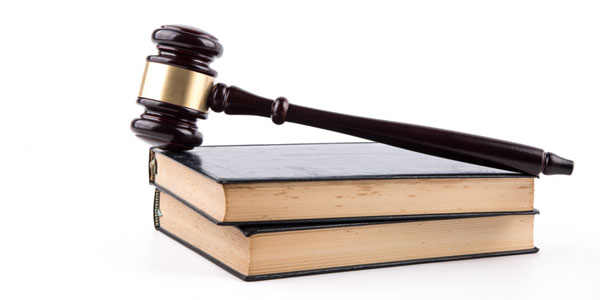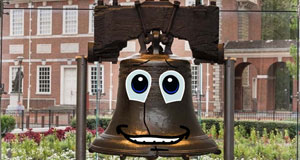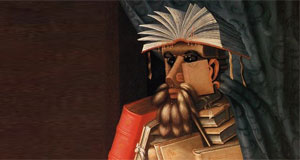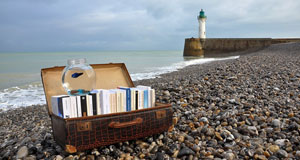Artifact Interviews
Students will research a historical person or event and retell the story as an animated interview with an artifact from that time or place.
App: Frames™
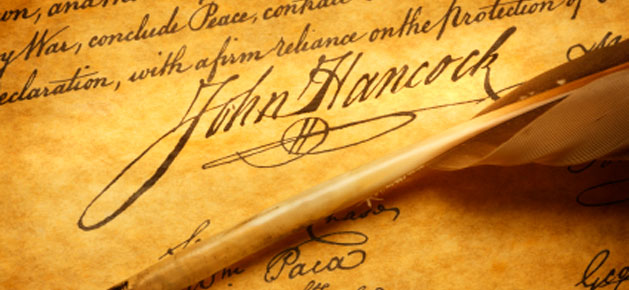
Task
Do you ever wonder what John Hancock’s quill must have felt like signing the Declaration of Independence? Or imagined what a freedom rider’s backpack heard and saw in 1961? Here is your chance to give a voice to an important historical artifact. Research a historical event or person and share your new found knowledge and opinions as you conduct an interview with an object that was there!
Engage
Many students find history boring, seeing it as a collection of dates and events. But history is much richer than that; it can help us understand people, society, change, and even ourselves.
To help get beyond facts and dates, let students know that they will be telling history through an interview with an object, or artifact, from a specific time or place. Choosing an object will help them connect to a point-of-view and consider the questions behind the events, not just the events themselves.
To kick off their thinking, recite Arthur Guiterman’s “Routine” to your students.
- Routine
- No matter what we are and who,
- Some duties everyone must do:
- A Poet puts aside his wreath
- To wash his face and brush his teeth,
- And even Earls
- Must comb their curls,
- And even Kings
- Have underthings.
Have students choose a person or event they would like to explore further. Before choosing an object, students should collecting knowledge and information about the event and begin taking notes.
Ask students to begin with the 5 W’s (who, what, when, where, how). To keep these from turning into the questions and answers in the interview, ask students to take this information and craft an introduction to the artifact being interviewed.
The research process isn’t designed to find the answers, but to help students determine the questions to ask, and more importantly, determine why this person or event is worth being studied. Have students reread their research notes to find a central idea or lesson learned. A Fact and Opinion organizer can help students identify themes or ideas that arise from our view of the facts.
What are the issues surrounding this event? Why do we remember this person? What big idea will the viewer take away or learn from this interview that goes beyond the facts or information?
Create
Explore and share a few example of personification with your students and then work together to personify an object in your classroom. Brainstorm feelings the object might have about itself or how it is used. To help students better “become the object,” ask them these prompting questions:
- What do you think about what you see, feel, hear, taste, and smell?
- What do you look like? What does that tell me about you?
- What are you afraid of?
- What do you dream of?
- How do you feel about the people or objects you meet?
Ask students to reread their research notes and brainstorm a list of artifacts from that time or place they could personify to tell the story. Have them write a list of character traits that make sense for each particular object. For example, a floor mat will have a different perspective (and may be grumpier!) than a chandelier; a shoe travels whereas a lamp watches from a single location. Encourage them to “become the objects” again and answer the same prompting questions.
A great interviewee doesn’t just share the facts, but expresses feelings and opinions about an event. Have students revisit their list of potential objects to interview and choose the artifact they think will best personify the perspective they want to share.
Once they have chosen an object, students should return to their research and begin to craft the questions they will ask the object. They should work to craft questions that elicit responses that go beyond the facts, such as: “What made you...?” and “Why did...?” and “How did you feel when...?”
Once the list of questions is complete, students should begin crafting the answers the object will give. These answers should reflect the character traits they identified and include the object’s feelings and actions during events.
The answers to the interview questions should be a blend of informational/explanatory and narrative writing. While retelling may seem like it should rely on conveying information accurately, the use of an artifact allows for a narrative approach to convey experience as well as to inform. The narrative should also provide clues to the personality and motive of the character and should be crafted with careful consideration of voice.
Have students use the drawing tools in Frames to create an illustration of their character. They can also search the library for appropriate clip art images.
Students can use images in the backgrounds folders to find an appropriate location for the interview or use the tools to draw their own. Students can find photographs of objects and locations by exploring the Pics4Learning folder in the Library or using the Search field at the bottom of the Library panel.
The Library also includes a set of Cartoon Faces that have multiple mouth images they can use to make an object talk. To ensure they are familiar with the process of drawing and animating an interview, have them complete the Animated News Report tutorial for Frames.
Once the initial frames are created for the artifact speaking, students should record narration for both the interviewer and interviewee. They can then duplicate the speaking frames to the appropriate duration of the voice narration.
To simplify the process, instead of showing the object talking, simply have a single frame showing the interviewer and the interviewee when talking. This is illustrated in the difference between the Waco Bridge interview and the Pontiac interview.
When the animated interview is complete, have students export the project as a video that can be easily shared online.
Share
Have the students present their animated interviews to the rest of the class. Invite other teachers or local historians to help evaluate the final products.
Share the stories and animations on your school web site, during morning announcements, or in your school or community library. You may also be able to share them on your local access television station as a celebration of student learning.
If students choose interviewed artifacts found at a local museum or buildings in your city, share the interview animations with the staff and even local government and history board.
Assessment
The final historical interview serves as a fantastic performance task for research as well as informational writing. Depending on style it may also be a great combination of informative and narrative writing. You may also want to assess the team work, responsibility, organization, and problem solving.
To support student progress, be sure to conduct formative assessments during the process. Start with discussions you have around different time periods or the artifacts you encountered on a field trip or site visit.
As student begin their own research, review their notes and information organizers to help them clarify thinking and comprehension of the informational texts they are encountering.
Explore the lists of questions they have developed to guide the interview. Evaluate the lists for breadth and complexity. Do the questions hit at the heart of an issue or just review facts? Use a written draft of the students’ questions and answers as another check-in point.
Resources
A. Suzanne Flynn. Autobiography of an Enchanted Object; or Mirror, Mirror. ISBN: 1477480471
Janet Hoskins. Biographical Objects: How Things Tell the Stories of Peoples’ Lives. ISBN: 0415920124
Dawn Raffel. The Secret Life of Objects. ISBN: 193754303X
Digital Primary Sources: Entice students to question and analyze with natural complexity.
Standards
Common Core State Standards for English Language Arts
Literacy in History/Social Studies - Reading Theme
CCSS.ELA-Literacy.RH.6-8.1 Cite specific textual evidence to support analysis of primary and secondary sources.
CCSS.ELA-Literacy.RH.6-8.6 Identify aspects of a text that reveal an author’s point of view or purpose (e.g., loaded language, inclusion or avoidance of particular facts).
Writing Theme
CCSS.ELA-Literacy.WHST.6-8.2 Write informative/explanatory texts, including the narration of historical events, scientific procedures/ experiments, or technical processes.
CCSS.ELA-Literacy.WHST.6-8.2a Introduce a topic clearly, previewing what is to follow; organize ideas, concepts, and information into broader categories as appropriate to achieving purpose; include formatting (e.g., headings), graphics (e.g., charts, tables), and multimedia when useful to aiding comprehension.
CCSS.ELA-Literacy.WHST.6-8.7 Conduct short research projects to answer a question (including a self-generated question), drawing on several sources and generating additional related, focused questions that allow for multiple avenues of exploration.
ISTE NETS for Students 2016:
3. Knowledge Constructor
Students critically curate a variety of resources using digital tools to construct knowledge, produce creative artifacts and make meaningful learning experiences for themselves and others. Students:
a. plan and employ effective research strategies to locate information and other resources for their intellectual or creative pursuits.
b. evaluate the accuracy, perspective, credibility and relevance of information, media, data or other resources.
c. curate information from digital resources using a variety of tools and methods to create collections of artifacts that demonstrate meaningful connections or conclusions.
6. Creative Communicator
Students communicate clearly and express themselves creatively for a variety of purposes using the platforms, tools, styles, formats and digital media appropriate to their goals. Students:
a. choose the appropriate platforms and tools for meeting the desired objectives of their creation or communication.
b. create original works or responsibly repurpose or remix digital resources into new creations.
c. communicate complex ideas clearly and effectively by creating or using a variety of digital objects such as visualizations, models or simulations.
d. publish or present content that customizes the message and medium for their intended audiences.





